Business is all about speed, and business success is all about how fast you get the right information.
Using outdated technology when there are newer, faster, easier-to-maintain, and cheaper-to-deploy solutions on the market can do a great disservice to your business. If you’re not fast, your competitors will be. That’s why you should always be on the lookout for new opportunities that can benefit your business in the future.
So what’s in store for web and software development in 2019? We asked our experts to share their own experiences and observations on what technologies and approaches our partners are requesting more often this year. This information may help you make some predictions and start planning your development for the next year.
This article highlights the top development trends we believe will be important next year for our team, our partners, and businesses worldwide. Be sure to find out first!
Data science
Businesses worldwide are using artificial intelligence, or AI, for data collection, visualization, analysis, and reporting in order to run processes automatically without involving developers and administrators.
For modern businesses, it’s becoming increasingly important to have systems that can change behavior for each user depending on their preferences, create new rules and behaviors based on processed data, visualize usage statistics, and provide convenient reports.
There are several fields where machine learning is commonly used, according to our developers:
- Marketing, support, and sales. Customization and personalization in marketing, customer care, and sales are one of the biggest trends these days. Machine learning can easily solve these tasks as it allows showing certain content to certain groups of people at every stage of the marketing funnel, setting up lead scoring, establishing cross-sell and up-sell strategies based on user behavior, analyzing and improving the customer experience on websites, and so on. The study by BrightEdge confirms this idea:
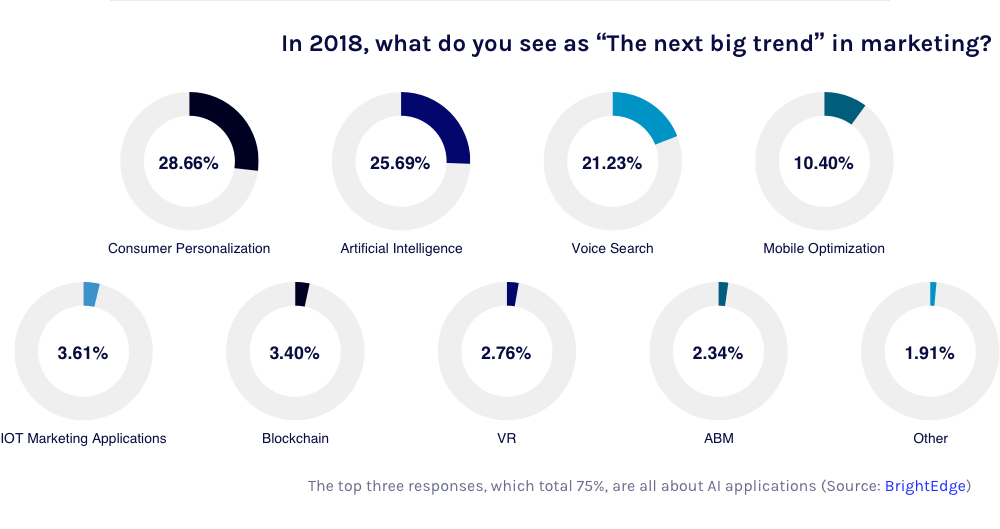
- Risk scoring and security. This is the most important field for financial institutions, as AI systems can detect and prevent fraudulent transactions.
- Credit scoring. Banks tend to use statistical methods and AI-based scoring models to determine if credit applicants will default on loans.
- Resource allocation. AI can help businesses automatically plan resource allocation and time. For example, one of our projects is planning to use AI to optimize the load of workers. By collecting statistics, the AI system will automatically compose schedules, distribute the load, and efficiently plan each employee’s day.
Microservice architecture
Our developers, especially those who work with ecommerce, telecommunications, and oil and gas businesses, point out that there’s great demand for microservice architectures these days.
A microservice architecture is a collection of small, independent services built to serve a single business functionality. The microservice software architecture allows you to divide a system into small services that are flexible, composable, and complete. These services can be implemented in different programming languages and on different platforms.
Here are several benefits of this approach:
- Microservices make working with several teams easier. Teams can use different programming languages for different services and still have a system that implements a single business functionality.
- Compared to monolithic systems, microservices are more flexible, scalable, and easier to build and maintain.
- Each microservice is independent, so if one of your services goes down it won’t affect the rest of your system.
- If some new technology appears, you сan use it for your future microservices, even if the old ones are written on other technologies.
- There’s no need to scale all components together; you can scale only those services that are being used more.
Each of these benefits helps our partners speed up their time to market as different teams can work on different components simultaneously without having to wait for each other to finish. And of course the faster you deliver, the more income you get.
React + Redux
React is a JavaScript library for building user interfaces that was developed by Facebook and is used by large companies including Netflix and Apple. Our developers confirm that during 2018 they encountered this library more and more frequently, and Google Trends shows the same picture:
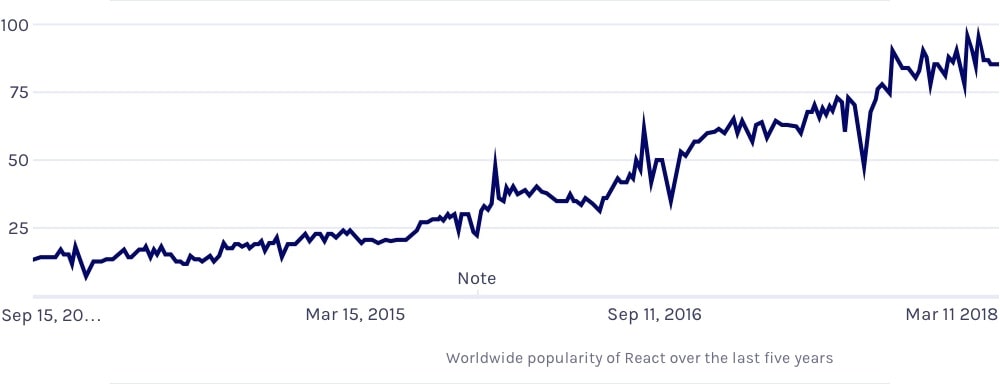
React implements a modular approach for building applications. What does that mean? The main idea of React is building complex UIs from components, or small and isolated pieces of code.
The beauty of the modular approach is that once you’ve created and tested a component, you can easily use it in other applications. React is also fast, responsive, user-friendly, and SEO-friendly.
Redux is an open source JavaScript library for managing application state that’s often used along with React. In fact, it connects components with required data. Using the connect function that comes with Redux, you can connect any component to the Redux data store and that component can pull the data it needs.
Cloud-based solutions
Our developers tell us that in 2018 our partners in FinTech, telecommunications, and ecommerce are more frequently requesting solutions that can be deployed in the cloud. Cloud computing is computing based on the internet. Put simply, you don’t download cloud-based software on your physical computer but instead access it through your browser.
Here are a few reasons why our partners are switching to cloud computing:
- There’s no need to buy expensive servers and it’s easier to scale the system, manage load, and integrate products. You can pay per month for the storage you need and never pay for storage you don’t use.
- It’s possible to connect to the business anytime and anywhere, which means you and your team members aren’t tied to the office and laptop. Once you’re in the cloud, you can get access to your data from any device, which gives you a little more freedom.
- Cloud-based services allow you to optimize costs by using resources of cloud computing service providers. These providers usually offer automatic system upgrades, which means you don’t have to think about maintaining your service.
- Cloud-based providers offer quick data recovery and reliable security.
Internet of Things
According to Statista, the number of devices connected to the internet is more than 23 billion in 2018, and this number may grow to 75 billion by 2025.
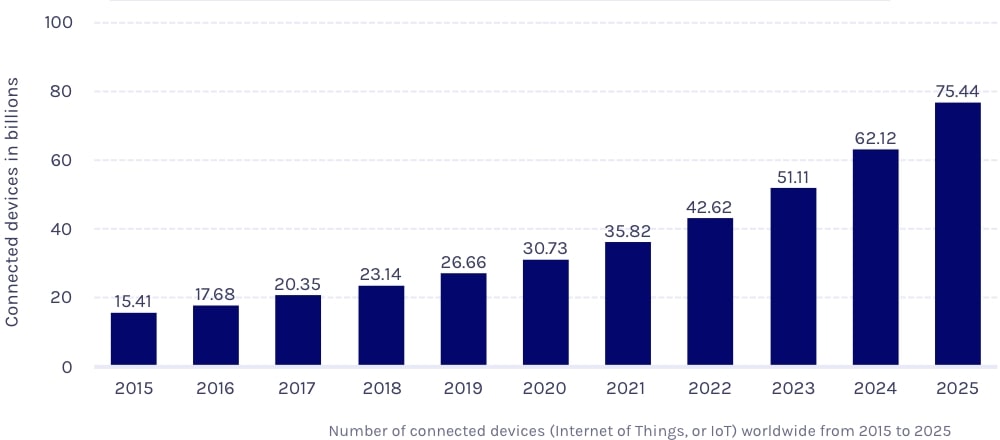
In a nutshell, the Internet of Things is a network of devices that connect and share data with one another without human intervention. Smart kettles that can be turned on remotely via smartphone, devices that help track down your lost keys, and systems that keep your plants fed are examples of IoT products.
IoT can be used in any industry where something can be automated, but according to our developers, the spheres most commonly implementing IoT are ecommerce, transport and logistics, and telecommunications.
Retail businesses often use IoT solutions to detect how customers are engaging with their products and to run real-life A/B testing.
Transport and logistics companies use IoT solutions to track vehicles, determine when it’s time to leave, see if a vehicle needs repairs, and so on.
Telecom providers bundle personalized smart home solutions with telephone, TV, and mobile services. Telecom businesses are trying to simplify the capabilities of service management for IoT as much as possible. They’re moving beyond the ordinary telecommunications channels (calls, SMS, TV) to cover all possible needs of the client, starting with the purchase of a mobile phone and going through the entire process of using telecom services.
Most promising languages in 2019
Here are the most promising programming languages for 2019 according to our developers’ experience and statistics from respected sources:
JavaScript
The 2018 Stack Overflow developer survey shows that JavaScript has remained the most used programming language six years in a row.
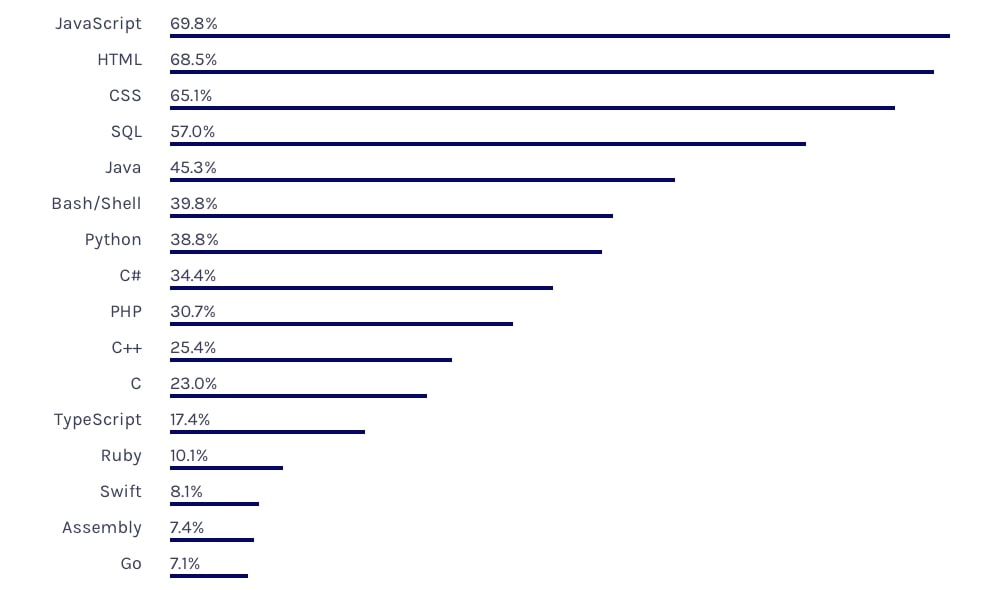
This high-level programming language can be used for frontend and backend development and allows building fast and high-performance web, desktop, and mobile apps. Our programmers point out that in fact JavaScript can do everything effectively and easily, and that’s why it remains popular.
Java
Java ranks first in the TIOBE Index, a respected rating of programming languages.
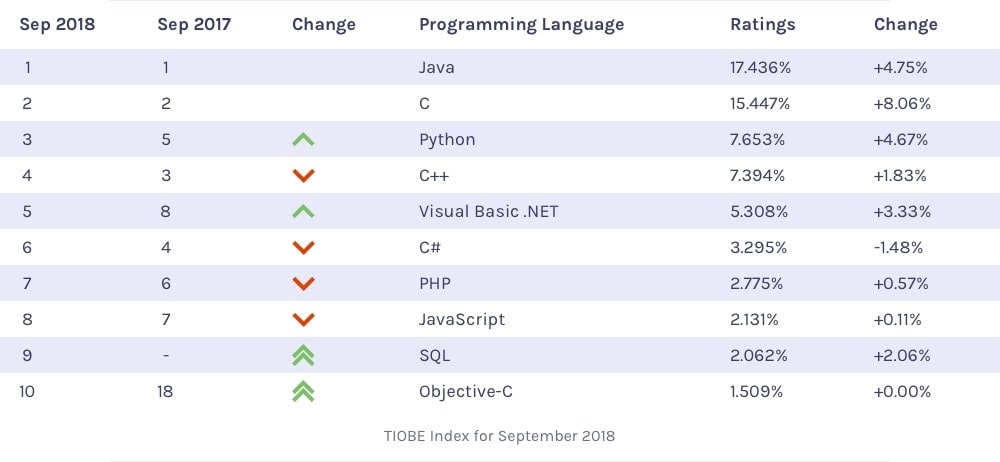
Java is one of the most popular programming languages in the world. With Java, you can write anything: Android applications, complex software, desktop applications, and games. That’s why Java won’t lose its popularity in 2019.
Python
The popularity of Python has grown rapidly over the last few years:
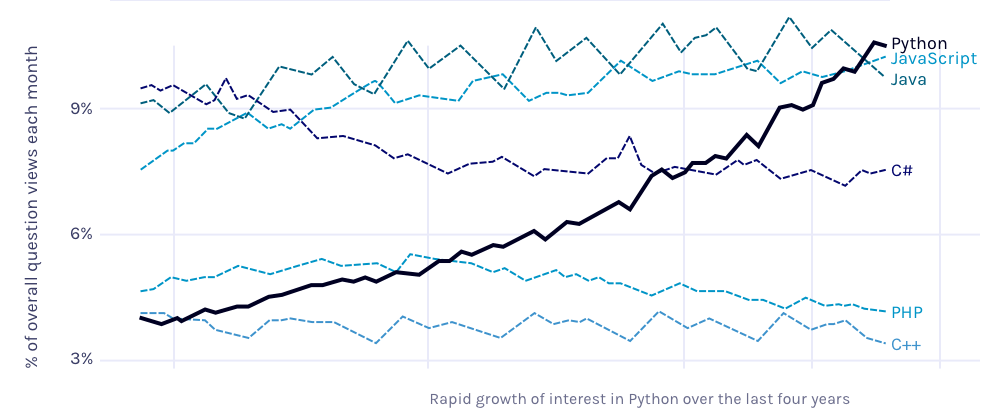
The incredible growth of interest in this language has a simple explanation: Python is a great language for machine learning, neural networks, and big data analysis. Since there are constant growth and demand for data science, Python is gaining popularity too, and it isn’t expected to lose ground in the coming decades.
Takeaways
When you choose a technology stack for your project, the main thing you should focus on is speed to market. That’s why you should follow the latest trends to choose the best business solutions and technologies, stay relevant, and deliver faster than your competitors. This white paper considers several of the latest trends based on recent statistics and the experience of HYS Enterprise developers.
- Data-driven solutions to run processes automatically without involving developers and administrators (frequently used in FinTech).
- Microservice architectures to speed up time to market while working with several teams (frequently used in ecommerce, telecommunications, and the oil and gas industry).
- React + Redux to develop fast, responsive, user-friendly, and SEO-friendly apps (frequently used in ecommerce).
- Cloud-based solutions to make software development more flexible and easier to maintain (frequently used in FinTech, telecommunications, and ecommerce).
- Internet of Things to automate everything that can be automated (frequently used in ecommerce, transport and logistics, and telecommunications).
